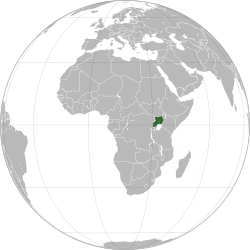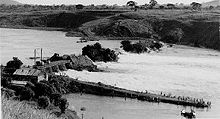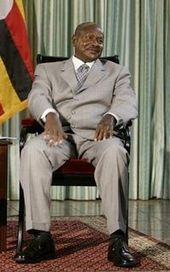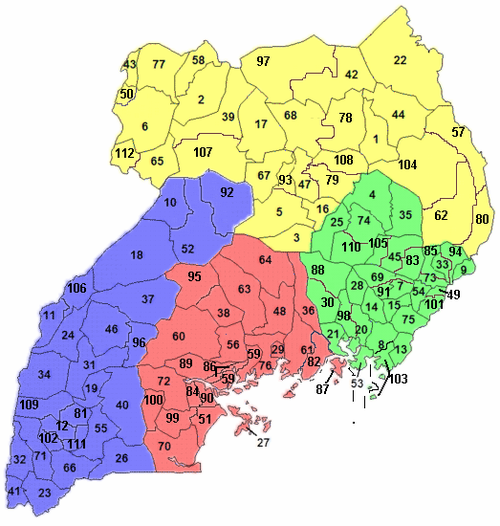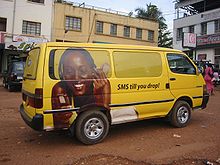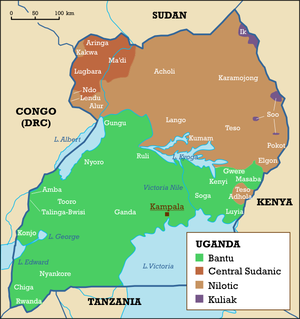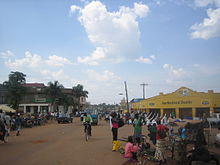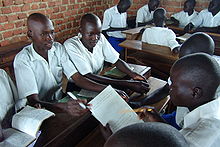- Uganda
-
Republic of Uganda
Jamhuri ya Uganda

Flag Coat of arms Motto: For God and My Country Anthem: "Oh Uganda, Land of Beauty" Capital
(and largest city)Kampala Official language(s) English,[1] Swahili Vernacular languages Luganda, Luo, Runyankore, Runyoro, Ateso, Lumasaba, Lusoga, Lunyole, Samia Demonym Ugandan Government Dominant-party system - President Yoweri Museveni - Prime Minister Amama Mbabazi Independence - from the United Kingdom 9 October 1962 Area - Total 236,040 km2 (81st)
91,136 sq mi- Water (%) 15.39 Population - 2009 estimate 32,369,558[2] (37th) - 2002 census 24,227,297 - Density 137.1/km2 (80th)
355.2/sq miGDP (PPP) 2010 estimate - Total $42.194 billion[3] - Per capita $1,226[3] GDP (nominal) 2010 estimate - Total $17.703 billion[3] - Per capita $514[3] Gini (1998) 43 (medium) HDI (2010)  0.422 (low) (143rd)
0.422 (low) (143rd)Currency Ugandan shilling ( UGX)Time zone EAT (UTC+3) - Summer (DST) not observed (UTC+3) Drives on the left ISO 3166 code UG Internet TLD .ug Calling code +2561
1 006 from Kenya and Tanzania.Coordinates: 1°17′N 32°23′E / 1.28°N 32.39°E
Uganda (
 /juːˈɡændə/ yew-gan-də or /juːˈɡɑːndə/ yew-gahn-də), officially the Republic of Uganda, is a landlocked country in East Africa. Uganda is also known as the "Pearl of Africa". It is bordered on the east by Kenya, on the north by South Sudan, on the west by the Democratic Republic of the Congo, on the southwest by Rwanda, and on the south by Tanzania. The southern part of the country includes a substantial portion of Lake Victoria, which is also bordered by Kenya and Tanzania.
/juːˈɡændə/ yew-gan-də or /juːˈɡɑːndə/ yew-gahn-də), officially the Republic of Uganda, is a landlocked country in East Africa. Uganda is also known as the "Pearl of Africa". It is bordered on the east by Kenya, on the north by South Sudan, on the west by the Democratic Republic of the Congo, on the southwest by Rwanda, and on the south by Tanzania. The southern part of the country includes a substantial portion of Lake Victoria, which is also bordered by Kenya and Tanzania.Uganda takes its name from the Buganda kingdom, which encompassed a portion of the south of the country including the capital Kampala.
The people of Uganda were hunter-gatherers until 1,700 to 2,300 years ago, when Bantu-speaking populations migrated to the southern parts of the country.[4] Uganda gained independence from Britain on 9 October 1962.
The official languages are English and Swahili, although multiple other languages are spoken in the country.
Contents
History
Main article: History of UgandaThe Ugandans were hunter-gatherers until 1,700 to 2,300 years ago. Bantu-speaking populations, who were probably from central Africa, migrated to the southern parts of the country.[4][5] These groups brought and developed ironworking skills and new ideas of social and political organization. The Empire of Kitara covered most of the great lakes area, from Lake Albert, Lake Tanganyika, Lake Victoria, to Lake Kyoga. Its leadership headquarters were mainly in what became Ankole, believed to have been run by the Bachwezi dynasty in the fourteenth and fifteenth centuries, who may have followed a semi-legendary dynasty known as the Batembuzi. Bunyoro-Kitara is claimed as the antecedent of later kingdoms; Buganda, Toro, Ankole and Busoga.[6] The Nilotic Luo invasion is believed to have led the collapse of Chwezi empire. The twins Rukidi Mpuuga and Kato Kintu are believed to be the first kings of Bunyonro and Buganda after the Chwezi Empire collapsed, creating the Babiito and Bambejja Dynasty. Nilotic people including Luo and Ateker entered the area from the north, probably beginning about A.D. 120. They were cattle herders and subsistence farmers who settled mainly the northern and eastern parts of the country. Some Luo invaded the area of Bunyoro and assimilated with the Bantu there, establishing the Babiito dynasty of the current Omukama (ruler) of Bunyoro-Kitara.[7] Luo migration continued until the 16th century, with some Luo settling amid Bantu people in Eastern Uganda, with others proceeding to the western shores of Lake Victoria in Kenya and Tanzania. The Ateker (Karimojong and Iteso) settled in the northeastern and eastern parts of the country, and some fused with the Luo in the area north of Lake Kyoga.
Arab traders moved inland from the Indian Ocean coast of East Africa in the 1830s. They were followed in the 1860s by British explorers searching for the source of the Nile. Protestant missionaries entered the country in 1877, followed by Catholic missionaries in 1879.[8] The United Kingdom placed the area under the charter of the British East Africa Company in 1888, and ruled it as a protectorate from 1894.
As several other territories and chiefdoms were integrated, the final protectorate called Uganda took shape in 1914. From 1900 to 1920, a sleeping sickness epidemic killed more than 250,000 people,[9] about two-thirds of the population in the affected lake-shore areas.[10]
Uganda gained independence from Britain in 1962, maintaining its Commonwealth membership. The first post-independence election, held in 1962, was won by an alliance between the Uganda People's Congress (UPC) and Kabaka Yekka (KY). UPC and KY formed the first post-independence government with Milton Obote as executive Prime Minister, the Buganda Kabaka (King) Edward Muteesa II holding the largely ceremonial position of President[11][12] and William Wilberforce Nadiope, the Kyabazinga (paramount chief) of Busoga, as Vice President.[citation needed]
In 1966, following a power struggle between the Obote-led government and King Muteesa, the UPC-dominated Parliament changed the constitution and removed the ceremonial president and vice president. In 1967, a new constitution proclaimed Uganda a republic and abolished the traditional kingdoms. Without first calling elections, Obote was declared the executive President.[13]
After a military coup in 1971, Obote was deposed from power and the dictator Idi Amin seized control of the country. Amin ruled Uganda with the military for the next eight years[14] and carried out mass killings within the country to maintain his rule. An estimated 300,000 Ugandans lost their lives at the hands of his regime.[15] Aside from his brutalities, he forcibly removed the entrepreneurial South Asian minority from Uganda, which left the country's economy in ruins.[16] Amin's atrocities were graphically accounted in the 1977 book, "A State of Blood," which was written by one of his former ministers after he fled the country.
Amin's reign was ended after the Uganda-Tanzania War in 1979 in which Tanzanian forces aided by Ugandan exiles invaded Uganda. This led to the return of Obote, who was deposed once more in 1985 by General Tito Okello. Okello ruled for six months until he was deposed after the so called "bush war" by the National Resistance Army (NRA) operating under the leadership of the current president, Yoweri Museveni, and various rebel groups, including the Federal Democratic Movement of Andrew Kayiira, and another belonging to John Nkwaanga.
Museveni has been in power since 1986. In the mid- to late 1990s, he was lauded by the West as part of a new generation of African leaders.[17] His presidency has included involvement in the civil war in the Democratic Republic of Congo (DRC) and other conflicts in the Great Lakes region, as well as the civil war against the Lord's Resistance Army, which has been guilty of numerous crimes against humanity including child slavery and mass murder. Conflict in northern Uganda has killed thousands and displaced millions.[citation needed]
Government
Main article: Politics of UgandaThe President of Uganda, currently Yoweri Kaguta Museveni, is both head of state and head of government. The President appoints a Vice President, currently Edward Ssekandi, and a prime minister, currently Amama Mbabazi, who aid him in governing. The parliament is formed by the National Assembly, which has 332 members. 104 of these members are nominated by interest groups, including women and the army. The remaining members are elected for five-year terms during general elections.[18]
Political parties were restricted in their activities from 1986, in a measure ostensibly designed to reduce sectarian violence. In the non-party "Movement" system instituted by Museveni, political parties continued to exist, but they could only operate a headquarters office. They could not open branches, hold rallies, or field candidates directly (although electoral candidates could belong to political parties). A constitutional referendum canceled this nineteen-year ban on multi-party politics in July 2005. Additionally, the constitutional term limit for the presidency was changed from the previous two-term limit, in order to enable the current president to continue in active politics.
The presidential elections were held in February, 2006. Yoweri Museveni ran against several candidates, the most prominent of whom being the exiled Dr. Kizza Besigye.
On Sunday, 20 February 2011, the Uganda Electoral Commission declared the 24-year reigning president Yoweri Kaguta Museveni the winning candidate of the 2011 elections that were held on the 18th of February 2011. The opposition were, however, not satisfied with the results, condemning them as full of sham and rigging[citation needed]. According to the results released, Museveni won with 68% of the votes, easily topping his nearest challenger Kizza Besigye. Besigye, who was formerly Museveni's physician, told reporters that he and his supporters 'downrightly snub' the outcome as well as the unremitting rule of Museveni or any person he may appoint. Besigye added that the rigged elections would definitely lead to an illegitimate lead and that it is up to Ugandans to critically analyse this.[citation needed]
The EU Election Observation Mission reported on improvements and flaws of the Ugandan electoral process: "The electoral campaign and polling day were conducted in a peaceful manner [...] However, the electoral process was marred by avoidable administrative and logistical failures that led to an unacceptable number of Ugandan citizens being disfranchised."[19]
Yoweri Museveni will be heading Uganda for another 5 years, with the next elections anticipated to be held in 2016.
Geography
Main article: Geography of UgandaThe country is located on the East African plateau, lying mostly between latitudes 4°N and 2°S (a small area is north of 4°), and longitudes 29° and 35°E. It averages about 1,100 metres (3,609 ft) above sea level, and this slopes very steadily downwards to the Sudanese Plain to the north. However, much of the south is poorly drained, while the centre is dominated by Lake Kyoga, which is also surrounded by extensive marshy areas. Uganda lies almost completely within the Nile basin. The Victoria Nile drains from the lake into Lake Kyoga and thence into Lake Albert on the Congolese border. It then runs northwards into South Sudan. One small area on the eastern edge of Uganda is drained by the Turkwel River, part of the internal drainage basin of Lake Turkana.
Lake Kyoga serves as a rough boundary between Bantu speakers in the south and Nilotic and Central Sudanic language speakers in the north. Despite the division between north and south in political affairs, this linguistic boundary actually runs roughly from northwest to southeast, near the course of the Nile. However, many Ugandans live among people who speak different languages, especially in rural areas. Some sources describe regional variation in terms of physical characteristics, clothing, bodily adornment, and mannerisms, but others claim that those differences are disappearing.
Mount Kadam, Uganda
Although generally equatorial, the climate is not uniform as the altitude modifies the climate. Southern Uganda is wetter with rain generally spread throughout the year. At Entebbe on the northern shore of Lake Victoria, most rain falls from March to June and the November/December period. Further to the north a dry season gradually emerges; at Gulu about 120 km from the South Sudanese border, November to February is much drier than the rest of the year.
The northeastern Karamoja region has the driest climate and is prone to droughts in some years. Rwenzori in the southwest on the border with Congo (DRC) receives heavy rain all year round. The south of the country is heavily influenced by one of the world's biggest lakes, Lake Victoria, which contains many islands. It prevents temperatures from varying significantly and increases cloudiness and rainfall. Most important cities are located in the south, near Lake Victoria, including the capital Kampala and the nearby city of Entebbe.
Although landlocked, Uganda contains many large lakes, besides Lake Victoria and Lake Kyoga, there are Lake Albert, Lake Edward and the smaller Lake George.
Districts, counties and kingdoms
See also: List of cities and towns in UgandaUganda is divided into districts, spread across four administrative regions: Northern, Eastern, Central (Kingdom of Buganda) and Western. The districts are subdivided into counties. A number of districts have been added in the past few years, and eight others were added on July 1, 2006 plus others added in 2010. There are now over 100 districts.[20] Most districts are named after their main commercial and administrative towns. Each district is divided into sub-districts, counties, sub-counties, parishes and villages.
Parallel with the state administration, six traditional Bantu kingdoms have remained, enjoying some degrees of mainly cultural autonomy. The kingdoms are Toro, Ankole, Busoga, Bunyoro, Buganda and Rwenzururu.
A clickable map of Uganda exhibiting its 111 districts and Kampala.Economy
Main articles: Economy of Uganda and Energy in UgandaFor decades, Uganda's economy suffered from devastating economic policies and instability, leaving Uganda as one of the world's poorest countries. The country has commenced economic reforms and growth has been robust. In 2008, Uganda recorded 7% growth despite the global downturn and regional instability.[21]
Uganda has substantial natural resources, including fertile soils, regular rainfall, and sizable mineral deposits of copper and cobalt. The country has largely untapped reserves of both crude oil and natural gas.[22] While agriculture used to account for 56% of the economy in 1986, with coffee as its main export, it has now been surpassed by the services sector, which accounted for 52% of percent GDP in 2007.[23] In the 1950s the British Colonial regime encouraged some 500,000 subsistence farmers to join co-operatives.[24] Since 1986, the government (with the support of foreign countries and international agencies) has acted to rehabilitate an economy devastated during the regime of Idi Amin and subsequent civil war.[2] Inflation ran at 240% in 1987 and 42% in June 1992, and was 5.1% in 2003.
Between 1990 and 2001, the economy grew because of continued investment in the rehabilitation of infrastructure, improved incentives for production and exports, reduced inflation and gradually improved domestic security. Ongoing Ugandan involvement in the war in the Democratic Republic of the Congo, corruption within the government, and slippage in the government's determination to press reforms raise doubts about the continuation of strong growth.
In 2000, Uganda was included in the Heavily Indebted Poor Countries (HIPC) debt relief initiative worth $1.3 billion and Paris Club debt relief worth $145 million. These amounts combined with the original HIPC debt relief added up to about $2 billion. In 2006 the Ugandan Government successfully paid all their debts to the Paris Club, which meant that it was no longer in the (HIPC) list. Growth for 2001–2002 was solid despite continued decline in the price of coffee, Uganda's principal export.[2] According to IMF statistics, in 2004 Uganda's GDP per capita reached $300, a much higher level than in the 1980s but still at half the Sub-Saharan African average income of $600 per year. Total GDP crossed the 8 billion dollar mark in the same year.
Economic growth has not always led to poverty reduction. Despite an average annual growth of 2.5% between 2000 and 2003, poverty levels increased by 3.8% during that time.[25] This has highlighted the importance of avoiding jobless growth and is part of the rising awareness in development circles of the need for equitable growth not just in Uganda, but across the developing world.[25]
With the Uganda securities exchanges established in 1996, several equities have been listed. The Government has used the stock market as an avenue for privatisation. All Government treasury issues are listed on the securities exchange. The Capital Markets Authority has licensed 18 brokers, asset managers and investment advisors including names like: African Alliance Investment Bank, Baroda Capital Markets Uganda Limited, Crane Financial Services Uganda Limited, Crested Stocks and Securities Limited, Dyer & Blair Investment Bank, Equity Stock Brokers Uganda Limited, Renaissance Capital Investment Bank and UAP Financial Services Limited.[26] As one of the ways of increasing formal domestic savings, Pension sector reform is the centre of attention (2007).[27][28]
Uganda traditionally depends on Kenya for access to the Indian Ocean port of Mombasa. Recently, efforts have intensified to establish a second access route to the sea via the lakeside ports of Bukasa in Uganda, and Musoma in Tanzania, connected by railway to Arusha in the Tanzanian interior and to the port of Tanga on the Indian Ocean.[29] Uganda is a member of the East African Community and a potential member of the planned East African Federation.
Demographics
Main article: Demographics of UgandaSee also: Languages of Uganda and Religion in UgandaUganda is home to many different ethnic groups, none of whom forms a majority of the population. Around forty different languages are regularly and currently in use in the country. English became the official language of Uganda after independence. Ugandan English is a local variant dialect.
The most widely spoken local language in Uganda is Luganda, spoken predominantly by the Ganda people (Baganda) in the urban concentrations of Kampala, the capital city and in towns and localities in the Buganda region of Uganda which encompasses Kampala. The Lusoga and Runyankore-Rukiga languages follow, spoken predominantly in the southeastern and southwestern parts of Uganda respectively.
Swahili, a widely used language throughout eastern and central East Africa, was approved as the country's second official national language in 2005,[30] though this is somewhat politically sensitive. Though the language has not been favoured by the Bantu-speaking populations of the south and southwest of the country, it is an important lingua franca in the northern regions. It is also widely used in the police and military forces, which may be a historical result of the disproportionate recruitment of northerners into the security forces during the colonial period. The status of Swahili has thus alternated with the political group in power.[31] For example, Amin, who came from the northwest, declared Swahili to be the national language.[32]
Uganda’s population has grown from 4.8 million people in 1950 to 24.3 million in 2002.[33] The current estimated population of Uganda is 32.4 million. Uganda has a very young population, with a median age of 15 years.[2]
Religion
Main article: Religion in Uganda Church in Entebbe
Church in Entebbe
According to the census of 2002, Christians made up about 84% of Uganda's population.[34] The Roman Catholic Church has the largest number of adherents (41.9%), followed by the Anglican Church of Uganda (35.9%). Evangelical and Pentecostal churches claim the rest of the Christian population. The next most reported religion of Uganda is Islam, with Muslims representing 12% of the population.[34] The Muslim population is primarily Sunni; there is also a minority belonging to the Ahmadiyya Muslim Community. The remainder of the population follow traditional religions (1%), Bahai (0.1%), or other non-Christian religions (0.7%), or have no religious affiliation (0.9%).[34]
Traditional indigenous beliefs are practiced in some rural areas and are sometimes blended with or practiced alongside Christianity or Islam. In addition to a small community of Jewish expatriates centered in Kampala, Uganda is home to the Abayudaya, a native Jewish community dating from the early 1900s. One of the world's seven Bahá'í Houses of Worship is located on the outskirts of Kampala. See also Bahá'í Faith in Uganda.
According to the World Refugee Survey 2008, published by the U.S. Committee for Refugees and Immigrants, Uganda hosted a population of refugees and asylum seekers numbering 235,800 in 2007. The majority of this population came from Sudan (162,100 persons), but also included refugees and asylum seekers from the Democratic Republic of the Congo (41,800), Rwanda (21,200), Somalia (5,700) and Burundi (3,100).[35]
Indian nationals are the most significant immigrant population; members of this community are primarily Ismaili (Shi'a Muslim followers of the Aga Khan) or Hindu. More than 30 years ago, there were about 80,000 Indians in Uganda. Today there are about 15,000.[36] The northern and West Nile regions are predominantly Catholic, while Iganga District in eastern Uganda has the highest percentage of Muslims. The rest of the country has a mix of religious affiliations.[37]
Health
Main articles: Health in Uganda and HIV/AIDS in UgandaUganda has been among the rare HIV success stories, one of the reasons being openness.[38] In the 1980s, more than 30% of Ugandan residents had HIV; this had fallen to 6.4% by the end of 2008, the most effective national response to AIDS of any African country.[39] This is supported by the findings of a 2006 study that modern contraceptive use in Uganda is low.[40]
Infant mortality rate was at 79 per 1,000 in 2005.[38] Life expectancy was at 50.2 for females, and 49.1 for males in 2005.[38] There were 8 physicians per 100,000 persons in the early 2000s.[38]
Uganda's elimination of user fees at state health facilities in 2001 has resulted in an 80% increase in visits; over half of this increase is from the poorest 20% of the population.[41] This policy has been cited as a key factor in helping Uganda achieve its Millennium Development Goals and as an example of the importance of equity in achieving those goals.[25]
Culture and sport
Main articles: Culture of Uganda, Music of Uganda, List of African writers (by country)#Uganda, and List of UgandansOwing to the large number of communities, culture within Uganda is diverse. Many Asians (mostly from India) who were expelled during the regime of Amin have returned to Uganda.[42]
Football is the most popular sport in Uganda[citation needed]. Games involving the national football team usually attract large crowds with Ugandans from all walks of life. The Ugandan Super League is the top division of Ugandan football contested by 16 clubs from across the country, it was created in 1968[citation needed]. Football in Uganda is managed by the Federation of Uganda Football Associations (FUFA). The association administers the national football team, as well as the Super League. South African broadcaster DStv through its Super Sport network broadcasts the Ugandan League to 46 different countries in sub Saharan Africa. Football is played all over Uganda especially by children in schools and young people on a variety of pitch surfaces. There is a strong following amongst Ugandans for European club football especially the English Premier League[citation needed] with London club Arsenal FC having the biggest following closely followed by Manchester United, Liverpool and Chelsea come in at a distant third and fourth respectively[citation needed]. Spanish side Barcelona has also attracted a sizable following in Uganda due to its recent run of success in La Liga and Uefa Champions League[citation needed]. Uganda's most famous footballers are David Obua of Scottish club Hearts, Ibrahim Sekagya who is the captain of the national team and Austria's Red Bulls and Nestroy Kizito[citation needed]. Uganda's notable past greats of the game include: Denis Obua, Majid Musisi, Fimbo Mukasa and Paul Kasule.
Cricket has experienced rapid growth although football is the most popular sport in Uganda[citation needed]. Recently in the Quadrangular Tournament in Kenya, Uganda came in as the underdogs and went on to register a historic win against archrivals Kenya[citation needed]. Uganda also won the World Cricket League (WCL) Division 3 and came in fourth place in the WCL Division 2. In February 2009, Uganda finished as runner-up in the WCL Division 3 competition held in Argentina, thus gaining a place in the World Cup Qualifier held in South Africa in April 2009[citation needed].
In 2007 the Ugandan Rugby Union team were victorious in the 2007 Africa Cup, beating Madagascar in the final[citation needed].
Rallying is also a popular sport in Uganda with the country having successfully staged a round of the African Rally Championship (ARC), Pearl of Africa Rally since 1996 when it was a candidate event. The country has gone on to produce African rally champions such as Charles Muhangi who won the 1999 ARC crown[citation needed]. Other notable Ugandans on the African rally scene include the late Riyaz Kurji who was killed in a fatal accident while leading the 2009 edition, Emma Katto, Karim Hirji, Chipper Adams and Charles Lubega. Ugandans have also featured prominently in the Safari Rally[citation needed].
Ugandans have since the early 1920s enjoyed the fast-paced sport of hockey[citation needed]. It was originally played by the Asians, but now it is widely played by people from other racial backgrounds. Hockey is the only Ugandan field sport to date to have qualified for and represented the country at the Olympics; this was at the Munich games in 1972. It is also believed in Ugandan hockey circles that Uganda's first and only Olympic gold medal may have been realized in part by the cheers from the representative hockey team that urged John Akii-Bua forward.[citation needed]
Also in July of 2011 Kampala,Uganda qualified for the 2011 Little League World Series in Williamsport, Pennsylvania for the first time beating Dharan LL in Saudi Arabia[43].
Education
Main article: Education in UgandaIlliteracy is common in Uganda, particularly amongst females.[38] Public spending on education was at 5.2 % of the 2002–2005 GDP.[38] Much public education in primary and secondary schools focus upon repetition and memorization. There are also state exams that must be taken at every level of education. Uganda has both private and public universities. The largest university in Uganda is Makerere University located outside of Kampala. The system of education in Uganda has a structure of 7 years of primary education, 6 years of secondary education (divided into 4 years of lower secondary and 2 years of upper secondary school), and 3 to 5 years of post-secondary education. The present system has existed since the early 1960s. Although an extent of primary education is compulsory under law, in many rural communities this is not observed as many families feel they cannot afford costs such as uniforms and equipment. State schools are usually run by the Church of Uganda and are built on land owned as such. In primary education, children sit exams at the end of each academic year in order to discern whether they are to progress to the next class; this leads to some classes which include a large range of ages. Upon completing S7 (The final year of primary education), many children from poorer rural communities will return to their families for subsistence farming. Secondary education is focused mainly in larger cities, with boarding optional. Children are usually presented with an equipment list which they are to fulfil at the beginning of their time at secondary school. This list classically includes items such as writing equipment, toilet roll and cleaning brushes, all of which the student must have upon admission to school.
Cuisine
Main article: Ugandan cuisine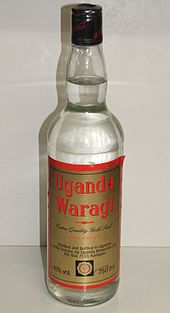 Uganda Waragi is a common alcoholic beverage in Uganda
Uganda Waragi is a common alcoholic beverage in Uganda
Ugandan cuisine consists of traditional cooking with English, Arab, Asian and especially Indian influences.[citation needed] Like the cuisines of most countries, it varies in complexity, from the most basic, a starchy filler with a sauce of beans or meat, to several-course meals served in upper-class homes and high-end restaurants.[citation needed]
Main dishes are usually centered on a sauce or stew of groundnuts, beans or meat. The starch traditionally comes from ugali (maize meal) or matoke (boiled and mashed green banana), in the South, or an ugali made from millet in the North. Cassava, yam and African sweet potato[clarification needed - Sweet potatoes are an American Indian crop] are also eaten; the more affluent include white (often called "Irish") potato and rice in their diets. Soybean was promoted as a healthy food staple in the 1970s and this is also used, especially for breakfast. Chapati, an Asian flatbread, is also part of Ugandan cuisine.
Human rights
Main article: Human rights in UgandaRespect for human rights in Uganda has improved significantly since the mid-1980s.[citation needed] There are, however, many areas which continue to attract concern.
Conflict in the northern parts of the country continues to generate reports of abuses by both the rebel Lord's Resistance Army (LRA) and the Ugandan Army. A UN official accused the LRA in February 2009 of "appalling brutality" in the Democratic Republic of Congo.[44] The number of internally displaced persons is estimated at 1.4 million. Torture continues to be a widespread practice amongst security organisations. Attacks on political freedom in the country, including the arrest and beating of opposition Members of Parliament, has led to international criticism, culminating in May 2005 in a decision by the British government to withhold part of its aid to the country. The arrest of the main opposition leader Kizza Besigye and the besiegement of the High Court during a hearing of Besigye's case by heavily armed security forces – before the February 2006 elections – led to condemnation.[45]
Recently, grassroots organisations have been attempting to raise awareness about children who were kidnapped by the Lord's Resistance Army to work as soldiers or be used as wives. Thousands of children as young as eight were captured and forced to kill. The documentary film Invisible Children illustrates the terrible lives of the children, known as night commuters, who still to this day leave their villages and walk many miles each night to avoid abduction.[46]
The U.S. Committee for Refugees and Immigrants reported several violations of refugee rights in 2007, including forcible deportations by the Ugandan government and violence directed against refugees.[35]
Homosexuality is illegal in Uganda. Gays and lesbians face discrimination and harassment at the hands of the media, police, teachers and other groups. In 2007, a Ugandan newspaper, The Red Pepper, published a list of allegedly gay men, many of whom suffered harassment as a result.[47] Also on October 9, 2010, the Ugandan newspaper Rolling Stone published a front page article—titled "100 Pictures of Uganda's Top Homos Leak"—that listed the names, addresses, and photographs of 100 homosexuals alongside a yellow banner that read "Hang Them".[48] The paper also alleged that homosexuals aimed to "recruit" Ugandan children. This publication attracted international attention and criticism from human rights organisations, such as Amnesty International,[49] No Peace Without Justice[50] and the International Lesbian, Gay, Bisexual, Trans and Intersex Association.[51] According to gay rights activists, many Ugandans have been attacked since the publication.[52] On January 27, 2011, gay rights activist David Kato was murdered.[53] Kato was on Rolling Stone's hitlist. Also a number of other gays and lesbian are missing and are believed to have been murdered.
Main article: Uganda Anti-Homosexuality BillThe Uganda parliament recently considered an Anti-Homosexuality Bill, if enacted, would have broadened the criminalisation of homosexuality by introducing the death penalty for people who have previous convictions, or are HIV-positive, and engage in same sex sexual acts. The bill also included provisions for Ugandans who engage in same-sex sexual relations outside of Uganda, asserting that they may be extradited back to Uganda for punishment, and included penalties for individuals, companies, media organisations, or non-governmental organisations that support LGBT rights. The private member's bill was submitted by MP David Bahati in Uganda on 14 October 2009, and is believed to have had widespread support in the Uganda parliament.[54] Debate of the bill was delayed in response to global condemnation.[55]
See also
- Outline of Uganda
- Index of Uganda-related articles
- Cabinet of Uganda
- Commonwealth of Nations
- Kisizi
- List of national parks of Uganda
- List of schools in Uganda
- Uganda AIDS Orphan Children Foundation
- The Uganda Scouts Association
- War/Dance
References
- ^ "Uganda: Society" in Library of Congress . Retrieved 29 June 2009.
- ^ a b c d e Central Intelligence Agency (2009). "Uganda". The World Factbook. https://www.cia.gov/library/publications/the-world-factbook/geos/ug.html. Retrieved January 23, 2010.
- ^ a b c d "Uganda". International Monetary Fund. http://www.imf.org/external/pubs/ft/weo/2010/01/weodata/weorept.aspx?sy=2007&ey=2010&scsm=1&ssd=1&sort=country&ds=.&br=1&c=746&s=NGDPD%2CNGDPDPC%2CPPPGDP%2CPPPPC%2CLP&grp=0&a=&pr.x=51&pr.y=5. Retrieved 2010-04-21.
- ^ a b East Africa Living Encyclopedia – Ethnic Groups, African Studies Center, University of Pennsylvania, http://www.africa.upenn.edu/NEH/uethnic.htm.
- ^ Phyllis Martin and Patrick O'Meara. Africa. 3rd edition. Indiana University Press, 1995.
- ^ Mwambutsya, Ndebesa, "Pre-capitalist Social Formation: The Case of the Banyankole of Southwestern Uganda.[dead link]" Eastern Africa Social Science Research Review 6, no. 2; 7, no. 1 (June 1990 and January 1991): 78–95.
- ^ "Origins of Bunyoro-Kitara Kings"[dead link], Bunyoro-Kitara website.
- ^ "Background Note: Uganda", U.S. State Department
- ^ Reanalyzing the 1900–1920 Sleeping Sickness Epidemic in Uganda, USA: Centers for Disease Control and Prevention (CDC), http://www.cdc.gov/ncidod/EID/vol10no4/02-0626.htm.
- ^ "The Cambridge history of Africa: From the earliest times to c. 500 BC". John D. Fage (1982). Cambridge University Press, p. 748. ISBN 0-521-22803-4
- ^ History of Parliament (Website of the Parliament of Uganda)
- ^ "Buganda Kingdom: The Uganda Crisis, 1966". Buganda.com. http://www.buganda.com/crisis66.htm. Retrieved 2010-05-03.
- ^ "Department of State. Background Note: Uganda". State.gov. 2010-02-03. http://www.state.gov/r/pa/ei/bgn/2963.htm. Retrieved 2010-05-03.
- ^ "A Country Study: Uganda", Library of Congress Country Studies
- ^ Keatley, Patrick (18 August 2003). "Obituary: Idi Amin". The Guardian. http://www.guardian.co.uk/news/2003/aug/18/guardianobituaries. Retrieved 2008-03-18.
- ^ "UK Indians taking care of business". Theage.com.au. March 8, 2006.
- ^ "New-Breed" Leadership, Conflict, and Reconstruction in the Great Lakes Region of Africa: A Sociopolitical Biography of Uganda's Yoweri Kaguta Museveni, Joseph Oloka-Onyango, Africa Today – Volume 50, Number 3, Spring 2004, p. 29
- ^ "Parliament of Uganda Website :: – COMPOSITION OF PARLIAMENT". Parliament.go.ug. http://www.parliament.go.ug/index.php?option=com_content&task=view&id=3&Itemid=4. Retrieved 2009-07-29.
- ^ "Uganda 2011 Elections". European Union Election Observation Mission. February 20, 2011. http://www.eueom.eu/files/pressreleases/english/press_release_preliminarystatement_uganda_20_february_en.pdf.
- ^ "Can Uganda’s economy support more districts?", New Vision, 8 August 2005
- ^ "Snapshot of Uganda's economic outlook". African Economic Outlook. July 6, 2009. http://www.africaneconomicoutlook.org/en/countries/east-africa/uganda/.
- ^ "Uganda's oil rush: Derricks in the darkness", The Economist, August 6th 2009, retrieved August 10th 2009.
- ^ "Uganda at a Glance". World Bank. November 13, 2009. http://devdata.worldbank.org/AAG/uga_aag.pdf.
- ^ Interview of David Hines in 1999 by W. D. Ogilvie; obituary of David Hines in London Daily Telegraph 8 April 2000 written by W. D. Ogilvie
- ^ a b c "Economic growth and the MDGs – Resources – Overseas Development Institute". ODI. http://www.odi.org.uk/resources/details.asp?id=4892&title=millennium-development-goals-equitable-growth-policy-brief. Retrieved 2011-05-31.
- ^ List of Licensed Investment Banks & Stock Brokerage Firms in Uganda
- ^ Kaujju, Peter. "Capital markets eye pension reform". The New Vision, June, 2008. Retrieved on February 9, 2009.
- ^ Rutaagi, Edgar. "Uganda Moving Towards Pension Reforms". The African Executive, 2009. Retrieved on February 9, 2009.
- ^ Tanzania And Uganda Agree To Speed Up Railway Project
- ^ "2005_Act 11" (PDF). http://www.ugandaonlinelawlibrary.com/files/constitution/Constitutional_Amendment_Act,_2005.pdf. Retrieved 2010-05-03.
- ^ Swahili in the UCLA Language Materials Project
- ^ "A Brief History of the Swahili Language", glcom.com
- ^ "Activists push for more reproductive health cash", The Observer, October 8, 2008
- ^ a b c "2002 Uganda Population and Housing Census – Main Report" (PDF). Uganda Bureau of Statistics. http://www.ubos.org/onlinefiles/uploads/ubos/pdf%20documents/2002%20Census%20Final%20Reportdoc.pdf. Retrieved 2008-03-26.
- ^ a b "World Refugee Survey 2008". U.S. Committee for Refugees and Immigrants. 2008-06-19. http://www.refugees.org/survey.[dead link]
- ^ Uganda: Return of the exiles. The Independent. August 26, 2005.
- ^ "U.S. Department of State". State.gov. http://www.state.gov/g/drl/rls/irf/2008/108397.htm. Retrieved 2009-07-29.
- ^ a b c d e f "Human Development Report 2009 – Uganda". Hdrstats.undp.org. http://hdrstats.undp.org/en/countries/data_sheets/cty_ds_UGA.html. Retrieved 2010-05-03.
- ^ "Background: HIV/Aids in Uganda". The Guardian. December 1, 2008
- ^ http://pdf.usaid.gov/pdf_docs/PNADO565.pdf
- ^ http://www.odi.org.uk/resources/download/4895.pdf
- ^ "Kampala Journal; Cast Out Once, Asians Return: Uganda Is Home". The New York Times. 1993. http://www.nytimes.com/1993/03/22/world/kampala-journal-cast-out-once-asians-return-uganda-is-home.html?scp=1&sq=indians%20return%20to%20uganda&st=cse. Retrieved September 29, 2011.
- ^ "Frustrating View of Game Day". The New York Times. 2011. http://www.nytimes.com/2011/08/20/sports/baseball/ugandans-watch-little-league-world-series-from-home.html?_r=1&ref=uganda. Retrieved September 29, 2011.
- ^ (AFP) – February 10, 2009 (2009-02-10). "AFP: Attacks of 'appalling brutality' in DR Congo: UN". Google.com. http://www.google.com/hostednews/afp/article/ALeqM5jjDmW-YliFMFYnBOvy5bwN3-Ggtg. Retrieved 2009-07-29.
- ^ "Uganda: Respect Opposition Right to Campaign", Human Rights Watch, 19 December 2005
- ^ "Invisible Children of Uganda film website". Invisiblechildren.com. http://www.invisiblechildren.com/. Retrieved 2009-07-29.
- ^ "Lesbian, gay, bisexual and transgender people" Amnesty International Report 2007 Uganda. Accessed on 21 August 2007.
- ^ "Ugandan paper calls for gay people to be hanged", Xan Rice, guardian.co.uk, 21 October 2010
- ^ "Ugandan gay rights activist: ‘I have to watch my back more than ever'", 5 November 2010
- ^ "Uganda: Stop homophobic campaign launched by Rolling Stone tabloid", 14 October 2010, No Peace Without Justice
- ^ "Uganda Newspaper Published Names/Photos of LGBT Activists and HRDs – Cover Says 'Hang Them'", International Lesbian, Gay, Bisexual, Trans and Intersex Association
- ^ "Outcry as Ugandan paper names 'top homosexuals'", Simon Akam, The Independent, 22 October 2010
- ^ "Uganda gay rights activist David Kato killed", 27 January 2011, BBC news
- ^ Sharlet, Jeff (September 2010). "Straight Man's Burden: The American roots of Uganda's anti-gay persecutions". Harper's (Harper's Magazine Foundation) 321 (1,924): 36–48. http://www.harpers.org/archive/2010/09/0083101. Retrieved 2011-01-21.
- ^ Olukya, Godfrey. "Uganda's anti-gay bill delayed amid outcry". MSNBC. http://www.msnbc.msn.com/id/42987326. Retrieved 2011-05-31.
External links
- Uganda travel guide from Wikitravel
- Talking Ugandans Forum
- Chief of State and Cabinet Members
- Uganda entry at The World Factbook
- Uganda from UCB Libraries GovPubs
- Uganda at the Open Directory Project
- Wikimedia Atlas of Uganda
- Humanitarian news and analysis from IRIN – Uganda
- Humanitarian information coverage on ReliefWeb
- Map Uganda At UN.org
- Country Profile from BBC News
- Uganda Tourist Board
- Uganda travel guide from Wikitravel
- Uganda Humanist Schools Trust
- Radio France International – dossier on Uganda and Lord's Resistance Army
- Uganda Social Bookmarking;Discover and Share Uganda Web content and News
 Uganda topics
Uganda topicsCulture and
religionCricket · Demographics · Education · Football · Healthcare · Languages · LGBT rights · Media · Music · National theatre · Newspapers · Rugby · Wildlife ·
Roman Catholicism · Church of Uganda · Islam · Judaism · Hinduism · Orthodox Christianity
Geography Cities and towns · Districts · Counties · Sub-counties · National parks ·
Kampala · Gulu · Lake Victoria · Lake Albert · Mount ElgonPolitics Constitution · President · Prime Minister · Cabinet · Political parties · Human rights · Terrorism · Foreign relationsEconomy and
infrastructureAgriculture · Central bank · Economy of Uganda · Energy · Fisheries · Forestry · Manufacturing · Ministry of Finance · Transport · Uganda Securities Exchange · Uganda shilling · Water supply · Entebbe Airport · Uganda Railways Corporation
 Regions and Districts of Uganda
Regions and Districts of UgandaCentral Eastern Amuria · Budaka · Bududa · Bugiri · Bukedea · Bukwa · Bulambuli · Busia · Butaleja · Buyende · Iganga · Jinja · Kaberamaido · Kaliro · Kamuli · Kapchorwa · Katakwi · Kibuku · Kumi · Kween · Luuka · Manafwa · Mayuge · Mbale · Namayingo · Namutumba · Ngora · Pallisa · Serere · Sironko · Soroti · TororoNorthern Western Mande Atlantic Savanna (other branches) Benue–Congo
CAR = Central African Republic • DRC = Democratic Republic of the CongoMember states of the African Union (AU) - Algeria
- Angola
- Benin
- Botswana
- Burkina Faso
- Burundi
- Cameroon
- Cape Verde
- Central African Republic
- Chad
- Comoros
- Democratic Republic of the Congo
- Republic of the Congo
- Côte d'Ivoire
- Djibouti
- Egypt
- Equatorial Guinea
- Eritrea
- Ethiopia
- Gabon
- The Gambia
- Ghana
- Guinea
- Guinea-Bissau
- Kenya
- Lesotho
- Liberia
- Libya
- Madagascar
- Malawi
- Mali
- Mauritania
- Mauritius
- Mozambique
- Namibia
- Niger
- Nigeria
- Rwanda
- Sahrawi Arab Democratic Republic
- São Tomé and Príncipe
- Senegal
- Seychelles
- Sierra Leone
- Somalia
- South Africa
- South Sudan
- Sudan
- Swaziland
- Tanzania
- Togo
- Tunisia
- Uganda
- Zambia
- Zimbabwe
Organisation of Islamic Cooperation (OIC) Members Afghanistan · Albania · Algeria · Azerbaijan · Bahrain · Bangladesh · Benin · Burkina Faso · Brunei · Cameroon · Chad · Comoros · Côte d'Ivoire · Djibouti · Egypt · Gabon · Gambia · Guinea · Guinea-Bissau · Guyana · Indonesia · Iran · Iraq · Jordan · Kuwait · Kazakhstan · Kyrgyzstan · Lebanon · Libya · Maldives · Malaysia · Mali · Mauritania · Morocco · Mozambique · Niger · Nigeria · Oman · Pakistan · Palestine · Qatar · Saudi Arabia · Senegal · Sierra Leone · Somalia · Sudan · Suriname · Syria · Tajikistan · Turkey · Tunisia · Togo · Turkmenistan · Uganda · Uzbekistan · United Arab Emirates · YemenObservers Countries and territoriesBosnia and Herzegovina · Central African Republic · Russia · Thailand · Northern Cyprus (as Turkish Cypriot State)Muslim communitiesInternational organizationsMembers of the Commonwealth of Nations Sovereign states - Antigua and Barbuda
- Australia
- Bahamas
- Bangladesh
- Barbados
- Belize
- Botswana
- Brunei
- Cameroon
- Canada
- Cyprus
- Dominica
- Fiji (suspended)
- The Gambia
- Ghana
- Grenada
- Guyana
- India
- Jamaica
- Kenya
- Kiribati
- Lesotho
- Malawi
- Malaysia
- Maldives
- Malta
- Mauritius
- Mozambique
- Namibia
- Nauru
- New Zealand
- Nigeria
- Pakistan
- Papua New Guinea
- Rwanda
- St. Kitts and Nevis
- St. Lucia
- St. Vincent and the Grenadines
- Samoa
- Seychelles
- Sierra Leone
- Singapore
- Solomon Islands
- South Africa
- Sri Lanka
- Swaziland
- Tanzania
- Tonga
- Trinidad and Tobago
- Tuvalu
- Uganda
- United Kingdom
- Vanuatu
- Zambia
Dependencies AustraliaNew ZealandUnited Kingdom- Akrotiri and Dhekelia
- Anguilla
- Bermuda
- British Antarctic Territory
- British Indian Ocean Territory
- British Virgin Islands
- Cayman Islands
- Falkland Islands
- Gibraltar
- Guernsey
- Isle of Man
- Jersey
- Montserrat
- Pitcairn Islands
- St. Helena, Ascension and Tristan da Cunha
- South Georgia and the South Sandwich Islands
- Turks and Caicos Islands
Categories:- Uganda
- African countries
- Bantu countries and territories
- East Africa
- English-speaking countries and territories
- Landlocked countries
- Least developed countries
- Member states of the African Union
- Member states of the Commonwealth of Nations
- Member states of the Organisation of Islamic Cooperation
- States and territories established in 1962
- Swahili-speaking countries and territories
- Member states of the United Nations
- Outline of Uganda
Wikimedia Foundation. 2010.

